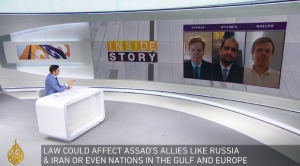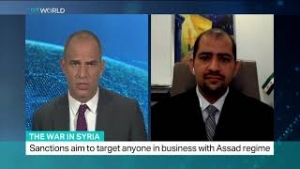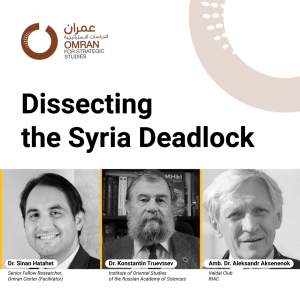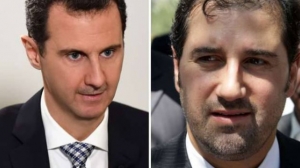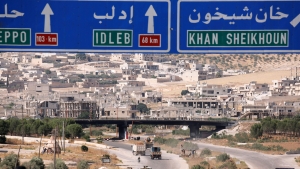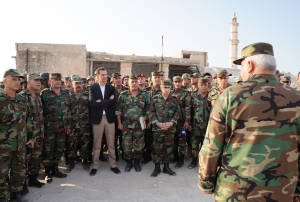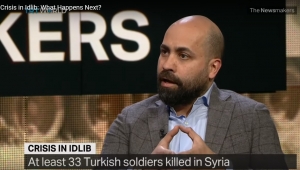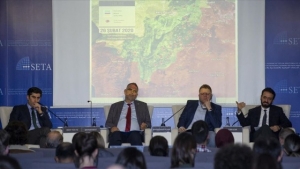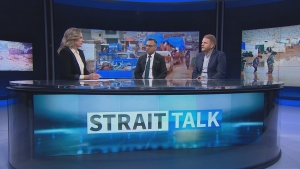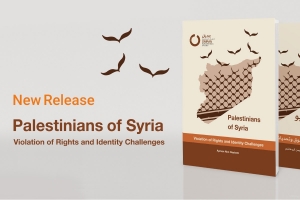Omran Center
Dr. Ammar Kahf | Will the Caesar Act defeat Syrian President Bashar al-Assad?
Dr. Ammar Kahf, Executive director of the Omran Center for Strategic Studies participated as a guest on Inside Story at Aljazeera English to discuss the latest Caesar Act and its impact on the Syrian regime. He highlighted that the root cause of torture, death, destruction and hunger has always been the regime of Bashar Assad. This is yet another tool that requires additional diplomatic and political mechanisms to put pressure on its sponsors and supporters to make their lives more difficult and think twice before normalizing or investing in reconstruction.
Other guests on the program included Joshua Landis and Alexey Khlebnikov. Sami Zeidan was the host of the program.
Source: https://bit.ly/3fHQmgy
Dr. Ammar Kahf | US sanctions on Assad regime "Caesar Act"
Dr. Ammar Kahf, Executive Director of the Omran Center for Strategic Studies gave his perspective on unpacks the new US sanctions on the Syrian regime on TRT WORLD channel.
Webinar | Dissecting the Syrian Deadlock
Omran for Strategic Studies held a webinar entitled "Dissecting the Syrian Deadlock" On 03 June 2020. The session attempted to shed light on the ongoing efforts to solve "the Syrian deadlock," and how the international community could end the current political stalemate.
Ambassador Dr. Aleksandr Aksenenok (Valdai Club, RIAC), and Dr. Konstantin Truevtsev (Institute of Oriental Studies of the Russian Academy of Sciences) shared their analysis and perceptions of the latest events in Syria, including the de-escalation deal in Idlib, the SDF - regime relations, the COVID-19 outbreak, the economic and political difficulties faced by al-Assad.
Dr. Ammar Kahf | Economic challenges in Syria
Dr. Ammar Kahf, the executive director of Omran Center for Strategic Studies, gave a comment on the latest developments regarding the economic challenges are facing Assad`s regime, to "THE MEDIA LINE" website.
to read the full report please follow the Link: "Upheaval in Syria’s First Family No Surprise"
Briefing on Latest Developments in Idlib
I. Introduction
Both Turkey and Russia agreed to a ceasefire in Idlib starting at midnight on March 5th,2020. At the time, both sides saw this agreement as representing the least worst case scenario to preserve its interests on the ground and prevent further escalation between different actors. On one side, the Russians and regime forces heavily escalated systematic attacks on civilians and basic infrastructures driving over 1.1 million civilians towards the Turkish borders, hence putting pressure on Turkey and indirectly on Europe. The regime aided by the Russian airforce regained control over vacated villages in the Idlib province and was advancing on more heavily populated areas. On the other hand, after several attacks by the regime against Turkish military forces, the Turkish army heavily escalated its presence and equipment in southern Idlib and broke away with previously agreed “rules of engagement” by attacking regime and Iranian backed forces to stop its advance and prevent further displacement of the civilian population. The agreement hence, was a temporary freeze of operations by all sides. It included the following core elements:
• A ceasefire from the morning of March 6, 2020 along the frontline.
Regime artillery continued to target several locations in the vicinity of the new buffer zone north of the M4, Sources confirmed that 56 violations done by the Regime March 6 to March 31 of the same month.
• Establishing a security corridor six kilometers north and six kilometers south of the main international highway in Idlib "M4," which links the cities controlled by the Syrian Regime in Aleppo and Lattakia, and open an internal crossing between the Regime and Opposition held areas.
Because of the new Corona (COVID19) and the fear of an outbreak of the disease, the interm government in Idlib decided to close all the internal and external borders in Idlib and western Aleppo, but in April 17, 2020 HTS announced its intention to open a commercial crossing with the regime that links both Saraqib and Sarmin, which met with widespread disapproval among civilians and demonstrated near Sarmin objecting to the matter.
• Joint Russian-Turkish patrols to be deployed along the M4 road, starting March 15.
As of April 18, 2020, no full joint patrols were conducted for the entire route for security and logistical reasons. A group of civilians built tents along parts of the road, refusing the passage of Russian patrols, while some military factions took advantage of the situation and worked to further destabilize the security situation. Sources of the Information Unit at Omran Center confirmed that these factions are affiliated with HTS. HTS has been taking steps to indirectly create problems and then present itself as part of the solution in an attempt to legitimize its presence in any future security architecture.
II. Updated map of control in Idlib and its surrounding areas

Updated Control map of Control in Idlib by Information Unit in Omran Centre – 18 April 2020
III. Major developments of the "M4" agreement
A. Turkey’s four current goals
1. Preventing the threat of Corona (COVID19) especially in IDP camps. This can be observed through the strict measures at border crossings, reducing to the maximum interactions with locals, pushing IHH organization to improve its plans, as well as high engagement by AFAD.
2. Increasing Turkish Military posts defense and sending more vehicles and soldiers in the past weeks to establish new posts in Jabal al-Zawyie and al-Ghab Plain.
3. Opposition factions: restructuring National Liberation Front (NLF) by arresting and demoting corrupt commanders, requesting from each faction to call fighters to training camps to compare numbers of fighters and ending any possible connection between groups and other countries in order to ensure order and containment.
4. The M4 agreement with Russia: Turkey is pushing hard for the joint patrols on M4, which has been facing obstacles through sit-in demonstrations by some local actors with direct threats from HTS sub-entities. Turkey is carefully trying to end this situation without using force and by negotiating with the locals. Resolving this situation is a top priority before May in order to prevent any Russian military acts.
B. Positions of local and international actors in Idlib
1. The joint patrols along the M4 highway is Russia’s main priority. There were little if any statements by Russia calling upon Turkey to implement the agreement during February-April, unlike early January. Russia is focusing on dealing with the Corona pandemic and countering increased ISIS threats in eastern Homs, Daraa, and Deir Ezzor.
2. Several news sources indicated that the UAE is pushing the regime to launch a new attack on Idlib and giving promises to fund such an operation. Russia asked the regime not to launch any attack after regime unilaterally and without consulting the Russians sent reinforcements to Idlib.
3. The presence of Iranian-backed militias in Idlib is less than other areas in Syria. However, for Iran to establish a foothold it needs to send more fighters and to launch a limited attack. IRGC-affiliated militias are present in Kafrnabel but are not the main attacking force. Once again, Iran is using its old methods: initial expansion in new areas followed by provision of basic services for local communities.
4. The recent Turkish/Russian agreement put further pressure on HTS by pushing it to re-share power in Idlib with NLF. Furthermore, the Turkish heavy military presence and the deal with the Russians is making Jihadist inside HTS angry and pushing them to breakout. This can be seen in the resignation of Abu Malek al-Talli, and the sit-in protests on the M4 by offshoot members of HTS.
5. HTS has been taking steps to restructure itself, and started by forming 3 new divisions and mixing the hardcore jihadist groups with other less radical members under the leadership of local members.
6. HTS seems to attempts to contain and weaken the more extreme elements within its ranks in order to reduce the risks of possible defections and ensure a future smooth transition from a Jihadi group to a political Islamist group. It is also taking steps to continue its local control over governing bodies such as the Salvation Government.
IV. Future directions
1. There will most likely not be a major regime attack in the near future and even from the opposition side too.
2. May is the month of action for the Turkish sides in order to get ready of the difficult situation surroundings the M4 agreement.
3. The area is witnessing more Iranian-backed militias activities, those activities will increase I. The future in different levels (Economic, Security and military)
4. COVID19 is not the main concern for the local and international actors in Idlib; positive reading is confirmed from the Opposition held areas in Idlib.
Power Centers in the Syrian Army: A Sectarian Approach
Executive Summary to Original Arabic Paper:
- Within the "Trinity of Leadership" approach which employed a sectarian balancing act, Hafez Al-Assad engineered the Syrian army’s centers of power in a manner that ensured loyalty to his regimes while preventing it from becoming a political tool against his authority. Post 2011 revolution, however, the sectarian engineering of the Syrian army tilted in favor of more Alawite officers assuming most leadership positions within the various layers of the army’s command.
- This paper examines the sectarian and territorial distribution of the most powerful 40 positions in the Syrian army as of March 2020. The paper concludes that those who occupy these sensitive positions are officers from the Alawite sect, including the Commander in Chief and the Minister of Defense, the commanders of the Military Corps, and the leaders of the intelligence branches of the Ministry of Defense.
- Latakia officers control 58% of leadership positions, Tartous officers control 17%, Homs officers 15%, while Hama officers control 10% out of these leading positions.
- There are undisclosed quotas between officers from Qardaha, Jableh, and Duraykish, where officers from Jableh command three corps and several powerful divisions. While Qardaha officers take command of a corps and an officer from Homs leads another corps.
- Qardaha officers take on the most powerful and varied of the military divisions. Whereas, two officers from the same village near Duraykish town, in the Tartous countryside, command the most powerful intelligence branches in Syria.
- The central powerful positions of the army are mainly occupied by officers from Latakia governorate, more specifically, from Jableh and Qardaha.
The following table shows the sectarian and territorial distribution of the most powerful forty positions in the Syrian army nowadays. The table also contains the names and regions of those high ranking officers including the Commander in Chief, the Minister of Defense, the Corps commanders and leaders of the formations and military division, in addition to some security and sensitive leading positions within the Syrian army:
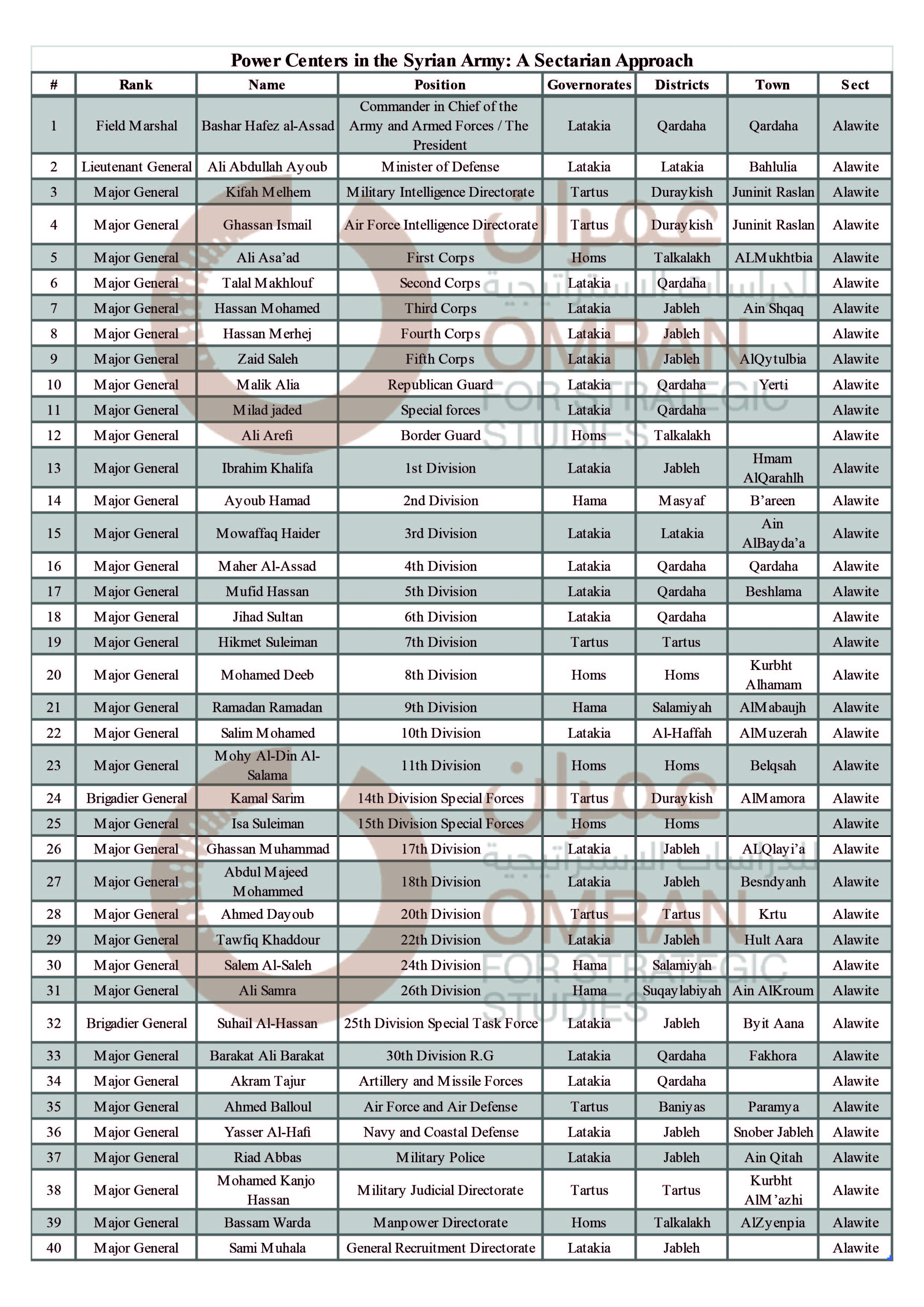
For More in Arabic: http://bit.ly/39QaU42
Mr. Yaser Tabbara | Crisis in IdlibWhat Happens Next
M Yaser Tabbara, co-founder of the Omran Center for Strategic Studies gave his perspective and analyses on the recent developments in Idlib and its surrounding; he was a guest on Newsmaker show in TRT world.
The show title was: Crisis in Idlib: What Happens Next
The Crisis in Idlib and the Changing Aspect of the Syrian War
Navvar Saban a Military expert at Omran for Strategic studies talked about the military situation in Idlib and the most recent developments during Feb 2020, at a panel titled "The Crisis in Idlib and the Changing Aspect of the Syrian War" was held at SETA for Political, Economic and Social Research in their main office in Ankara on 26 Feb.2020.
Saban added his own opinion about any possible future scenarios in this region, and spot the light about Hayat Tahrir al-Sham and what are the possible ways to deal with it presence, as its presence might act like a new invitation for the Russian to start a new military campaign against the remaining areas in Idlib.
The panel, moderated by Murat Yeşiltaş , the Director of Security Studies of the Political, Economic and Social Research Foundation ( SETA ) , The panel speakers were; SETA Foreign Policy Researcher Can Acun, and Deputy Director of Turkish Red Crescent Bayram Selvie.
Navver Saban | Humanitarian Situation in Idlib
Navvar Saban a Military expert at Omran for Strategic studies talked to TRT WORLD about the dire humanitarian situation in Idlib and possible refugee influx to Turkey. Where Russian and Syrian regime forces seized dozens of towns and villages from northwestern Syria, with the latter vowing to recapture Idlib. That caused mass displacement with more than 235,000 civilians fleeing their homes.
Palestinians of Syria.. Violation of Rights and Identity Challenges
Executive Summary
- Palestinian refugees in Syria have not been spared from the relentless violent policies of the Syrian regime. Gross violations have been committed against them, and they have experienced a rapid erosion of the rights afforded to them by both Syrian and international law. As of October 2019, documentation indicates that 3,995 Palestinian refugees in Syria—mostly young men—have been killed and 1,768 Palestinian refugees have been detained in the regime’s security and intelligence prisons. More than 568 Palestinian detainees of the victims, both male and female, have been tortured to death in regime detention. In addition, there have been 205 casualties who died due to starvation, lack of medical care, siege, and the semi-complete destruction of the Palestinian refugee camps of Daraa, Sbeineh, al-Sayida Zainab, and Handarat; the destruction of large parts of the camps in Khan al-Sheih and al-Husseinyeh; and the complete destruction of al-Yarmouk camp. Furthermore, more than 200,000 Palestinians have fled across the Syrian borders.
- Palestinian refugees in Syria have suffered and continue to suffer from intense threats and risks to their real property rights. Some of the Syrian laws issued in recent years provide cover for the government to strip owners of their own property. In addition, the tight security grip prevents the return of refugees and internally displaced persons (IDPs) to their original homes in the Palestinian camps. As a result, Palestinian refugees in Syria have experienced large-scale property expropriation for political purposes. At the same time, the USA and European countries still refuse to participate in the reconstruction of Syria until a political solution is reached and the United Nations Relief and Works Agency for Palestine Refugees in the Near East (UNRWA) is failing to shoulder the burden of rebuilding Palestinian camps due to its financial deficit and challenges to its very mandate.
- The relationship between UNRWA and the General Administration for Palestinian Arab Refugees (GAPAR) was governed by the checks and controls through which the Syrian authorities specified UNRWA’s role and the its geographical scope of work in Palestinian camps and communities. As a result of these restrictions and controls, UNRWA’s services have failed to reach the large number of refugees who need them, depriving thousands of refugees from the services and aid.
- Challenges facing the continuation of UNRWA’s mandate cannot be separated from the legal status of refugees, as UNRWA maintains the comprehensive civil record of the refugee assets in Palestine. This is considered the primary archive of transformations in their demographic status and a crucial source for confirming the international legal dimensions of their asylum.
- During the recent turmoil in Syria, the Palestine Liberation Organization’s (PLO) declared position of political neutrality towards the Syrian issue did nothing to prevent a series of marked violations of the civil rights of refugees. A profound shift in refugees’ perception of the PLO can be observed by looking at the positions of PLO’s leadership at various milestones in the conflict. Positions issued by PLO leaders contributed to covering up responsibility for the parties involve in such crimes as indiscriminate bombardment, siege, starvation, and detention of people in al-Yarmouk camp. Meanwhile, Palestinian factions loyal to the regime such as the Popular Front for the Liberation of Palestine – General Command, As-Sa’iqa, Fatah al-Intifada, Jabhat al-Nidal al-Sha'bi, and other militias, in addition to the Palestine Liberation Army, all participated in fighting alongside the regime and helped it impose the siege on al-Yarmouk camp.
- This research reveals the magnitude of the complex problems faced by Palestinian refugees in Syria by examining the paths of their migration and escape from the bloody war—which Palestinians in Syria lived through as their second catastrophe, or “Nakba”—and the crises and violations they have faced in neighboring countries and other places of exile. The failure of many States to comply with the 1951 Refugee Convention has magnified the suffering of refugees by denying them protection and aid, leaving them with limited options. As a result, many have found themselves and deprived of their rights and at risk of deportation and refoulement. This research presents various examples of the violations that Palestinian refugees have been exposed to due to their vulnerable legal status, such as: being detained in airports and holding centers for foreigners for long periods of time; being deported back to Syria or the threat thereof; being treated as foreigners or tourists rather than refugees fleeing a war; not being offered humanitarian assistance that would mitigate their suffering; etc.
- The risks and challenges facing the “Palestinian-Syrian identity” highlight the extent to which legal status and its transformations impact the holders of this identity. They face difficulties rebuilding and restoring their identity, not only in terms of place and collective memory, but also in terms of the disintegration of their legal status. This reveals a recognition of the importance of legal status and its implications for the configuration of identity and its open questions. It is especially so with the ambiguity of the future in Syria in general, and of options related to the legal status of Palestinians in Syria, in particular, opening the floor for multiple risks and challenges putting much doubt and posing major questions to the identity dialectic.
- One of the most important recommendations stemming from this research is to expose the Syrian authorities’ responsibility for the degradation of the legal status of the Palestinians of Syria. There should be a shift from monitoring and documenting violations to encouraging victims of these violations to take their cases to court in countries whose national laws allow for universal jurisdiction in such cases where the perpetrators committed war crimes and crimes against humanity. The research further recommends the formation of a special committee or commission to advocate for the property of Palestinian refugees in Syria and calls on all host countries and bodies concerned with managing the affairs of Palestinians of Syria to grant them their right of confirming their original Palestinian citizenship in all documents, records, and data. The findings demand that the PLO address the adverse effects of the lack of representation of refugees and urges the PLO to set up institutional mechanisms to unite the diaspora and represent their demands and rights. The research also emphasizes the importance of the persistence of UNRWA, the continuation of its foundational assistance mandate, and the exposure of schemes aimed at eliminating the cause of the refugees and eradicating their right of return to their homeland in Palestine as per UN General Assembly Resolution 194 (III).
- In light of the magnitude of issues facing Palestinians in Syria, including the disintegration of their legal status, the continued attrition of their presence inside Syria, and the difficulties faced by those forced to migrate and flee to other countries, all attempts to remedy and restore their status will depend on the course of and end to the conflict in Syria. There appear to be few current approaches or solutions that may reassure Palestinians about the future of their presence in Syria and move them towards a more secure legal status that guarantee their rights.

